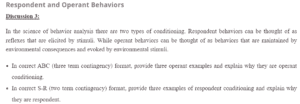Respondent and Operant Behaviors
The three-term contingency is referred to as the ABCs of behavior, which consists of the Antecedent, the Behavior, and the Consequence. An antecedent stimulus happens before the occurrence of the behavior. The behavior is the response, and the Consequences are how the behavior is reinforced or punished (Catania, 2017). Get in touch with us at eminencepapers.com. We offer assignment help with high professionalism.
An example of the ABC is Ann seeing several peach trees along the road, making her hungry (Antecedent). She stopped and picked the peaches and ate them (Behavior). The peaches were good and sweet, and she plans to travel that road more often (Consequence). Another example is when a teacher rings a bell to get the students’ attention (Antecedent). The students stop talking (Behavior). The classroom becomes quiet, and the teacher is able to make her announcement (Consequence). anytime they hear the bell in the future, they will know it is time to keep quiet.
A third example is when a student has difficulty following directions, which hinders him from completing class tasks. Whenever he is instructed to complete a task, he gets upset, screams “No,” refuses to complete any work assignments, runs around in the classroom, and lies on the floor. The teacher will target the behavior by providing positive reinforcement from the student. The teacher offers the student positive verbal praise and a sticker every 30 minutes when he completes an assignment, which includes following directions and not yelling. At the end of each day, staff will allow him to trade in his stickers for (1) item from the treasure box.
In the correct S-R (two-term contingency) format, provide three examples of respondent conditioning and explain why they are respondents.
For the early lot of behaviorists, the basic fact of conditioning was that it altered behavior and the theories that the behaviorists advanced were based on this fact. Conditioning is described as establishing a new response to a new stimulus previously having not elicited the same response. These naturally suggested that conditioning was about the formation of a new connection of stimulus-response. This conceptualization resulted in the development of the theory of stimulus-response, with its variations providing the dominant account of the S-R conditioning theories, which are key to the conditioning principles. These theories are based on the assumption that humans learn behavior. Stimuli can be either external or internal. External stimulus originates outside an organism, while internal stimulus originates from within an organism (Mittenberg, 2016).
The first example is when a family goes camping, and the father attempts to build a campfire. The father asks the daughter to collect sticks to start the fire. As the daughter picks up the sticks, she encounters a large bear and immediately runs away. This reaction is due to an external stimulus. When the daughter sees the bear, her brain registers fear and quickly activates the fight or flight response. Knowing she cannot confront the bear, the daughter opts for flight mode. A second example is when cold weather is an external stimulus that causes a person to respond by wearing a warm jacket.
As a third example, an internal stimulus example is feeling hunger pangs, thus prompting a person to eat food. The human body is designed to survive, and it does so through the help of homeostasis. The body adjusts effectively to the complex environment’s variable circumstances. Without hemostasis, internal stimuli would be lacking, so the body would not be prompted to respond. Hence, an internal stimulus is propelled by the need for the body to retain its homeostatic state.
References
Catania, A. C. (2017). The ABCs of behavior analysis. Corn-wall on Hudson: Sloan.
Miltenberger, R. (2016). Behavior modification: Principles and procedures. Nelson Education.
ORDER A PLAGIARISM-FREE PAPER HERE
We’ll write everything from scratch
Question
Respondent and Operant Behaviors
Discussion 3:

Respondent and Operant Behaviors
In the science of behavior analysis there are two types of conditioning. Respondent behaviors can be thought of as reflexes that are elicited by stimuli. While operant behaviors can be thought of as behaviors that are maintained by environmental consequences and evoked by environmental stimuli.
- Incorrect ABC (three-term contingency) format, provide three operant examples and explain why they are operant conditioning.
- In the correct S-R (two-term contingency) format, provide three examples of respondent conditioning and explain why they are respondents.

